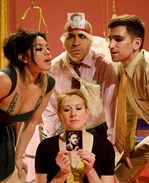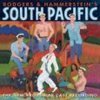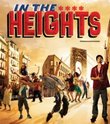SITE GUIDE
SEARCH
REVIEWS
REVIEW ARCHIVES
ADVERTISING AT CURTAINUP
FEATURES
NEWS
Etcetera and
Short Term Listings
LISTINGS
Broadway
Off-Broadway
NYC Restaurants
BOOKS and CDs
OTHER PLACES
Berkshires
London
California
New Jersey
DC
Connecticut
Philadelphia
Elsewhere
QUOTES
TKTS
PLAYWRIGHTS' ALBUMS
LETTERS TO EDITOR
FILM
LINKS
MISCELLANEOUS
Free Updates
Masthead
A CurtainUp Review
The Really Big Once
|
A play is not a poem.
—Tennessee Williams
|

(Clockwise from top left): Maria-Christina Oliveras, Steven Rattazzi, John Kurzynowski and McKenna Kerrigan
|
A bizarre experiment in surreal drama, Camino Real was understood by both men to be a huge gamble — for Williams because it represented such a departure from the realistic quality of most of his plays, and for Kazan because so much was riding on its success. Kazan's infamous testimony in front of the HUAC forever darkened his reputation with his peers and in casting Camino Real he felt keenly the pressure to be accepted again . . .and the disappointment when the production bombed.
Yet despite its spectacular failure, many who were involved in or saw the play considered it one of the most important experiences of their theatrical lives. In the Target Margin Theater / Ontological-Hysteric Incubator's production of The Really Big Once, director David Herskovits tackles the ghosts of Camino Real once again. It it fails as well, the way in which it fails may perhaps be the most important thing.
The Really Big Once attempts to tell the story of Camino Real's development process, drawing much of its dialogue from letters, journal entries and interviews with Williams and Kazan, friends and family, and attendees of the original play in 1953. Williams and Kazan themselves play (obviously) significant parts as characters, and each of the five actors get their turn at portraying the two men at various times throughout the production.
Trying to summarize or even describe the plot is a useless exercise (no single writer for the play is listed). Herskovits says that "we have woven together our play in the spirit of Williams' Camino, 'like water in the mountains, or clouds changing shape in a gale, or the continually dissolving and transforming images of a dream'. " That's more or less how it feels to watch the actors dance around a large carousel-like structure (dangling scripts, costumes, props and various other oddities from its central ring), jumping from character to character, time period to time period, in and out of commentary in and on the play, speaking variously to, with, and often over each other.
There's not much of a narrative throughline to be had here, and you search for one at your peril. This doesn't daunt the performers though and they deserve special note both for the commitment they show to the production and the skill they demonstrate in carrying it off.
McKenna Kerrigan, John Kurzynowski, Maria-Christina Oliveras, Hubert Point-Du Jour and Steven Rattazzi (all of whom play so many unnamed roles in addition to Williams and Kazan that singling one out is impossible) are equally good at going with the flow of the action, and on the whole this is excellent ensemble work. The technical demands of the production are admirably met by lighting designer Lenore Doxsee and especially the sound team of Jim Breitmeier, Kate Marvin and Herskovits. Laura Jellinek's set, combining the aforementioned "spinning wheel" with a smaller internal space which serves at various times as park, bordello and Williams' living room, is perfectly in keeping with the thrust of the play. In bringing the director's vision to life, this is professional work from beginning to end.
All of this brings me back to that "vision" thing. Normally in a review of this kind, all of what I've just said would be preparing me to lower the hammer on the play itself. The Really Big Once is all over the place, after all. It's incoherent, weird, bizarre and often irritating, too loud at times, too slow at others, wandering perilously close to self-indulgence and apparent sophomoric overreach on occasion. For all the obvious work which was done in bringing this production to stage, including exhaustive research into the history and reception of Camino Real, that work often gets undercut by its presentation — the actors often speak or yell long monologues over each other, making understanding of any of the speeches exceedingly difficult. Under most circumstances, I'd be tempted to dismiss this as a failed experiment.
But ultimately, I'm convinced that failure — or the nature of the failure— is really the point here, and in that regard the production succeeds brilliantly. Both Target Margin and OHI know their ways around an experimental canvas. Understood differently a play like this is exactly the way —perhaps the only one—to understand something as disastrously incoherent yet richly inspirational as Camino Real.
Actors scratch their heads reading laminated copies of letters from Williams to Kazan (and then letters from Kazan's widow to Herskovits in reference to this production), drift uncomfortably from dance rehearsals to mock improv acting sessions, even conduct a séance to get in touch with the ghosts of performances past. Through it all, discussions about preparing for The Really Big Once blend with those referring to Camino Real, tying together the work of both plays with surprising insight. One gets the sense that Herskovits knows that, like Kazan, he hasn't "touched [the play's] potential." Yetm unlike his predecessor, the modern director understands that locking something like this into a perfectly rendered but rigid performance misses the point.
From a traditional point of view, The Really Big Once is a mess. But it's also saying something important, and so this is one of those times when you have to put traditional views aside if you're going to get to something larger. If you're willing to do so, you'll find something both startlingly truthful and surprisingly compelling.
Editor's Note: Camino Real had one of its more successful production ten years ago at Williamstown Theatre Festival. To read that review go here.
|
The Really Big Once Director: David Herskovits Cast: McKenna Kerrigan, John Kurzynowski, Maria-Christina Oliveras, Hubert Point-Du Jour, Steven Rattazzi Lighting Designer: Lenore Doxsee Costume Designer: Carol Bailey Set Designer: Laura Jellinek Sound Team: Jim Breitmeier, David Herskovits, and Kate Marvin Running time: One hour, fifteen minutes The Ontological Theater at St. Mark's Church, 131 East 10th Street at Second Avenue, (212) 352-3101 Website: http://www.ontological.com From 4/13/10 to 5/08/10; opening 4/17/10 Tues., Thurs, Fri. @ 8 p.m., Sat. @ 5 p.m. and 8 p.m., Sun. @ 7 p.m. Tickets: $25 Reviewed by Dr. Gregory A. Wilson based on April 15th press performance |
|
REVIEW FEEDBACK Highlight one of the responses below and click "copy" or"CTRL+C"
Paste the highlighted text into the subject line (CTRL+ V): Feel free to add detailed comments in the body of the email. . .also the names and emails of any friends to whom you'd like us to forward a copy of this review. You can also contact us at Curtainup at Facebook , Curtainup at Twitter and at our Blog Annex |
|
Subscribe to our FREE email updates with a note from editor Elyse Sommer about additions to the website -- with main page hot links to the latest features posted at our numerous locations. To subscribe,
E-mail: esommer@curtainup.comesommer@curtainup.com
put SUBSCRIBE CURTAINUP EMAIL UPDATE in the subject line and your full name and email address in the body of the message -- if you can spare a minute, tell us how you came to CurtainUp and from what part of the country. |





